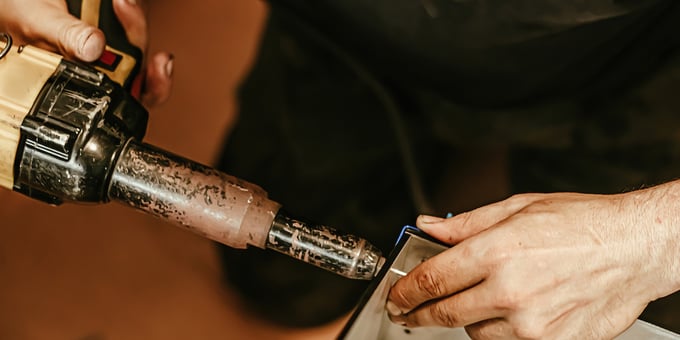
With several different types of riveting tools available—manual, pneumatic, and battery-powered—how do you know which is right for your job?
Although manual riveters are great for small jobs, power riveters are key to efficiently meeting production demands and maximizing labor costs. Here are some of the most important considerations to make sure you choose the right tool for your application, as well as our picks for pneumatic and battery-driven power riveters.
What to Consider
One of the main considerations for the type of power riveter you choose will depend largely on the volume of rivets you need to set, as well as the location in which you’re working—pneumatic devices require an air supply, which can limit their application.
Assessing the fastener setting capability of the tool is also critical. Many manufacturers of low-cost power riveters advertise their tools as capable of setting large diameter fasteners or rivets made of structural or stainless steel, but high-volume production may not be realistic. Why? Certain tools, when operating at their upper tolerance level, may experience greater wear and tear, resulting in greater downtime, which can negatively impact production.
Additionally, when deciding on the right power riveter for your job, it’s vital to consider cost versus quality. A lower-cost tool might be attractive to the bottom line, but it likely won’t last as long and will need to be replaced. The reality is that it’s always going to be more economically prudent to spend more upfront on an exceptionally reliable installation system than to replace a lower-cost option time and time again.
On the same note, it’s important to consider the type of material the tool is made out of because the right power riveter for your job will be able to withstand any work environment and be built to last. Replacing a cheaply made power riveter after it is dropped and the plastic cracks can hurt your bottom line and stall productivity, whereas a high-quality tool made from durable materials will last.
A final consideration relates to frequent mistakes made with power riveters. Fastener tools have specific nose assemblies or tips that are built and configured for a specific type of fastener, and each fastener in turn has a finite degree of grip range. Companies often use many fasteners and may require multiple different nose assemblies, and the pitfall is that many use incorrect nose assemblies for the type of fastener and application. Additionally, many companies use fasteners in applications at the top or bottom grip range of the tool, and this leads to issues with the reliability of the setting and greater wear and tear on the tool. Although manufacturers will blame these errors on faulty fasteners, it ultimately comes down to not having the right nose assemblies or tips for the right fastener on the right job. The lesson: Make sure you’re using the right power riveter components.
Pneumatic Tools
In a factory setting, a pneumatic power riveter offers a fast, efficient option allowing for quick and easily repeatable rivet setting.
Stanley Engineered Fastening offers two excellent options of pneumatic power riveters: the Avdel® 07200-00200 Pneumatic Power Tool and the Avdel® 07201-00200 Pneumatic Power Tool. This line of pneumatic tools are designed to place 3/16 inch and ¼ inch Avdelok® pins and collars at high speed, which makes them ideal for batch or flow-line assembly in any number of applications across various industries. Another excellent pneumatic power riveter is the Avdel® 07241-00001 Hydro-Pneumatic Power Tool, which is ideal for batch or flow-line assembly across applications and industries for placing Avdel breakstem rivets at high speed.
Battery-Powered Tools
Although pneumatic tools are the most common type of power riveter used in factory settings, recent improvements in battery-driven tool technology have many industries changing strategy. Battery-powered riveters mean no need to hassle with air hoses, and an updated lightweight, ergonomic design provides greater mobility across applications. Additionally, when working at a location with no access to air, a battery-operated power riveter is the only solution, and a battery-driven tool is particularly ideal for small-volume installation.
One of the best battery-powered riveters on the market is the Gesipa PowerBird® Pro 3300. A powerful and fast power riveter with a setting force of 15,000 N when setting blind rivets up to 6.4 mm in any material, the Gesipa PowerBird® Pro 3300 has a brushless motor for virtually no wear, shortened pulling process for immediate operation, and an increased stroke to set particularly long rivets.
If you’re ready to commit to a power riveter, contact us to get a quote. With fast shipping, expert guidance, and top-notch customer service, we’ll ensure you get the right tool for the job.



Comments